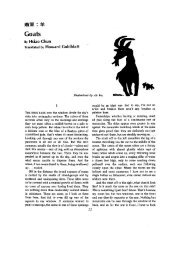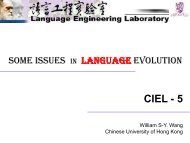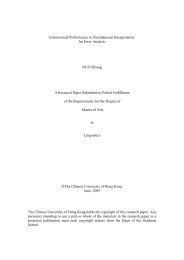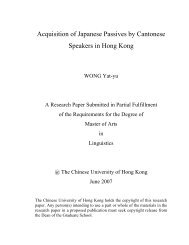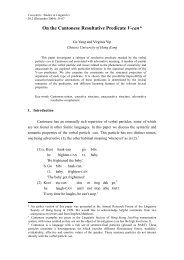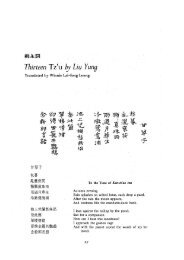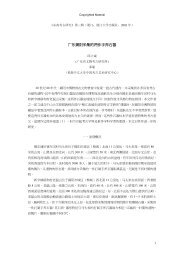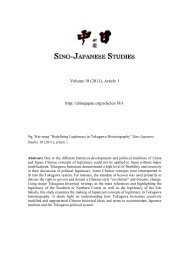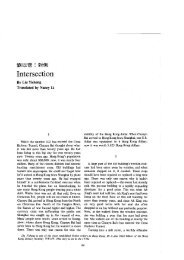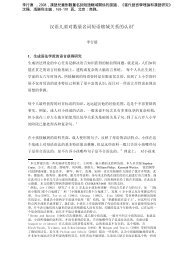Poetry and Courtier Culture in the Yongming Era - The Chinese ...
Poetry and Courtier Culture in the Yongming Era - The Chinese ...
Poetry and Courtier Culture in the Yongming Era - The Chinese ...
You also want an ePaper? Increase the reach of your titles
YUMPU automatically turns print PDFs into web optimized ePapers that Google loves.
《 中 國 文 化 研 究 所 學 報 》 Journal of Ch<strong>in</strong>ese Studies No. 53 - July 2011<br />
350<br />
Book Reviews<br />
<strong>in</strong> modern Ch<strong>in</strong>a. As described <strong>in</strong> <strong>the</strong> epilogue, traditional medic<strong>in</strong>e for women was<br />
still valued by doctors <strong>in</strong> Ch<strong>in</strong>a as a better alternative to Western obstetrics <strong>in</strong> <strong>the</strong> early<br />
twentieth century. <strong>The</strong> postpartum care meticulously analysed <strong>in</strong> <strong>the</strong> last chapter is still<br />
practised today <strong>and</strong> some of <strong>the</strong> concoctions are even globally commercialized.<br />
In <strong>the</strong>oretical terms, Wu brilliantly revises Furth’s notion of <strong>the</strong> <strong>and</strong>rogynous body<br />
<strong>and</strong> proposes ano<strong>the</strong>r way of imag<strong>in</strong><strong>in</strong>g <strong>the</strong> body as “<strong>in</strong>f<strong>in</strong>itive,” “one that serves as <strong>the</strong><br />
basis for all human bodies, to be conjugated <strong>in</strong>to male <strong>and</strong> female, young <strong>and</strong> old, robust<br />
<strong>and</strong> delicate, Sou<strong>the</strong>rn <strong>and</strong> Nor<strong>the</strong>rn, depend<strong>in</strong>g on circumstances” (p. 232). <strong>The</strong> <strong>in</strong>vention<br />
of fuke <strong>in</strong> <strong>the</strong> Song was thus not a production of gender difference, but a new way of<br />
expla<strong>in</strong><strong>in</strong>g gender differences. Such differences were m<strong>in</strong>imized <strong>in</strong> literate M<strong>in</strong>g-Q<strong>in</strong>g<br />
medic<strong>in</strong>e except for illnesses perta<strong>in</strong><strong>in</strong>g to childbirth. For Furth, late imperial doctors were<br />
“stepp<strong>in</strong>g back” from <strong>the</strong> Song dist<strong>in</strong>ctive female body. For Wu, <strong>the</strong>se doctors simply saw<br />
this female body as just a variation of <strong>the</strong> <strong>in</strong>f<strong>in</strong>itive body. In o<strong>the</strong>r words, it was no longer<br />
a question of <strong>the</strong> <strong>and</strong>rogynous or <strong>the</strong> gendered body, but that of a dist<strong>in</strong>ct <strong>in</strong>dividualized<br />
body that late imperial doctors came to be <strong>in</strong>terested <strong>in</strong>. This notion of <strong>the</strong> <strong>in</strong>f<strong>in</strong>itive body<br />
fur<strong>the</strong>r liberates our imag<strong>in</strong>ation of <strong>the</strong> body from all possible boundaries.<br />
Sound <strong>and</strong> Sight: <strong>Poetry</strong> <strong>and</strong> <strong>Courtier</strong> <strong>Culture</strong> <strong>in</strong> <strong>the</strong> Yongm<strong>in</strong>g <strong>Era</strong> (483–493). By Meow<br />
Hui Goh. Stanford, CA: Stanford University Press, 2010. Pp. xi + 192. $50.00.<br />
Sound <strong>and</strong> Sight is <strong>the</strong> latest contribution to <strong>the</strong> grow<strong>in</strong>g body of <strong>in</strong>terpretive scholarship<br />
by means of which we have been reassess<strong>in</strong>g <strong>the</strong> cultural heritage of <strong>the</strong> Six Dynasties<br />
over <strong>the</strong> last twenty years. In this book, Meow Hui Goh constructs a picture of <strong>the</strong> life of<br />
<strong>the</strong> courtier-poet <strong>in</strong> <strong>the</strong> Sou<strong>the</strong>rn Qi (479–502) through a close read<strong>in</strong>g of selected<br />
poems by Shen Yue (441–513), Xie Tiao (464–499), <strong>and</strong> Wang Rong <br />
(467–493), commonly recognized as <strong>the</strong> three foremost poets active <strong>in</strong> <strong>the</strong> decade-long<br />
reign of Emperor Wu , when Qi court culture reached its zenith.<br />
Look<strong>in</strong>g back over Six Dynasties literary scholarship of <strong>the</strong> past decade, one feels<br />
that a book-length treatment of <strong>the</strong>se three major poets was simply wait<strong>in</strong>g to be written.<br />
Richard Ma<strong>the</strong>r’s magisterial compendium of annotated translations of <strong>the</strong> poetic corpora<br />
of all three 1<br />
furnished a basis for comparison <strong>in</strong> mak<strong>in</strong>g new <strong>in</strong>terpretations; Cynthia<br />
1<br />
Richard B. Ma<strong>the</strong>r, <strong>The</strong> Age of Eternal Brilliance: Three Lyric Poets of <strong>the</strong> Yung-m<strong>in</strong>g <strong>Era</strong><br />
(483–493) (Leiden: Brill, 2003), <strong>in</strong> which he builds upon <strong>the</strong> work begun <strong>in</strong> <strong>The</strong> Poet Shen<br />
Yüeh (441–513): <strong>The</strong> Reticent Marquis (Pr<strong>in</strong>ceton, NJ: Pr<strong>in</strong>ceton University Press, 1988), a<br />
detailed study of Shen Yue’s life, thought, <strong>and</strong> writ<strong>in</strong>gs.<br />
© 香 港 中 文 大 學 <strong>The</strong> Ch<strong>in</strong>ese University of Hong Kong
《 中 國 文 化 研 究 所 學 報 》 Journal of Ch<strong>in</strong>ese Studies No. 53 - July 2011<br />
Book Reviews 351<br />
Chennault’s study of yongwu shi (“poems about objects”) <strong>in</strong> <strong>the</strong> Sou<strong>the</strong>rn Qi 2 laid<br />
<strong>the</strong> ground for fur<strong>the</strong>r analysis of <strong>the</strong> place of this vitally important sub-genre <strong>in</strong> <strong>the</strong>ir<br />
work; <strong>and</strong> Xiaofei Tian’s portrait of <strong>the</strong> literary culture of <strong>the</strong> Liang 3 (<strong>in</strong> which Shen<br />
Yue, who survived his fellow poets to rise to even greater em<strong>in</strong>ence, figures prom<strong>in</strong>ently)<br />
was an <strong>in</strong>vitation to write a “prequel” extend<strong>in</strong>g <strong>the</strong> treatment of overlapp<strong>in</strong>g issues<br />
back <strong>in</strong>to <strong>the</strong> preced<strong>in</strong>g dynasty. 4 Build<strong>in</strong>g on <strong>the</strong>se foundations, Goh has struck out <strong>in</strong><br />
a different direction <strong>and</strong>, out of simple constituents, developed a spare <strong>and</strong> elegant new<br />
<strong>the</strong>sis.<br />
<strong>The</strong> author beg<strong>in</strong>s with <strong>the</strong> term shengse , literally, <strong>the</strong> “sound <strong>and</strong> sight” of<br />
her title. In its orig<strong>in</strong>al mean<strong>in</strong>g of “pleasures of <strong>the</strong> senses,” shengse has always carried<br />
strong overtones of moral condemnation, 5 which Shen Deqian (1673–1769),<br />
writ<strong>in</strong>g on literary history, co-opted to describe what he saw as an excessive preoccupation<br />
with ornate surfaces <strong>in</strong> Six Dynasties poetry <strong>and</strong> <strong>the</strong> disastrous eclipse of fundamental<br />
values that this betokened. Goh sets out to redef<strong>in</strong>e shengse as a morally neutral literary<br />
term, especially as applied to <strong>the</strong> experiments of <strong>the</strong> poets of <strong>the</strong> Yongm<strong>in</strong>g era out<br />
of which was born <strong>the</strong> dist<strong>in</strong>ctive period style known as Yongm<strong>in</strong>g ti . “Sound”<br />
refers to a heightened sensitivity to <strong>the</strong> sounds of words that <strong>in</strong>spired <strong>the</strong>se poets to make<br />
<strong>the</strong> prosodic <strong>in</strong>novations <strong>in</strong>volv<strong>in</strong>g tonal anti<strong>the</strong>sis with which <strong>the</strong> Yongm<strong>in</strong>g style has<br />
become identified; 6 “sight” refers to <strong>the</strong> keen <strong>in</strong>terest <strong>the</strong>y showed <strong>in</strong> <strong>the</strong> world around<br />
2<br />
3<br />
4<br />
5<br />
6<br />
Cynthia L. Chennault, “Odes on Objects <strong>and</strong> Patronage dur<strong>in</strong>g <strong>the</strong> Sou<strong>the</strong>rn Qi,” <strong>in</strong> Studies<br />
<strong>in</strong> Early Medieval Ch<strong>in</strong>ese Literature <strong>and</strong> Cultural History: In honor of Richard B. Ma<strong>the</strong>r<br />
<strong>and</strong> Donald Holzman, ed. Paul W. Kroll <strong>and</strong> David R. Knechtges (Provo, UT: T’ang Studies<br />
Society, 2003), pp. 331–98.<br />
Xiaofei Tian, Beacon Fire <strong>and</strong> Shoot<strong>in</strong>g Star: <strong>The</strong> Literary <strong>Culture</strong> of <strong>the</strong> Liang (502–557)<br />
(Cambridge, MA: Harvard University Asia Center, 2007).<br />
Out of a substantial bibliography of English <strong>and</strong> Ch<strong>in</strong>ese sources, Goh cites <strong>the</strong>se three with<br />
<strong>the</strong> greatest frequency.<br />
Goh cites an early use <strong>in</strong> a Shang dynasty proclamation that strictly disapproves sensual<br />
<strong>in</strong>dulgence; however, s<strong>in</strong>ce all <strong>the</strong> pre-Zhou material <strong>in</strong> <strong>the</strong> Shang shu actually dates<br />
from <strong>the</strong> late Warr<strong>in</strong>g States, this cannot be attested.<br />
Shen Yue is historically credited (or taxed, as <strong>the</strong> case may be) with <strong>the</strong> <strong>in</strong>vention of tonal<br />
prosody, but it is more likely that he was only one of a number of poets contribut<strong>in</strong>g to <strong>the</strong><br />
formation of a <strong>the</strong>ory that reached full elaboration only <strong>in</strong> <strong>the</strong> h<strong>and</strong>s of <strong>the</strong> early Tang poets—<br />
<strong>the</strong> <strong>in</strong>famous “four tones <strong>and</strong> eight defects” (sisheng bab<strong>in</strong>g ) that have been <strong>the</strong><br />
bane of Ch<strong>in</strong>ese school children ever s<strong>in</strong>ce. <strong>The</strong> author argues that <strong>the</strong> <strong>the</strong>ory was attributed<br />
to Shen through a deliberate act of <strong>in</strong>terpolation <strong>in</strong> <strong>the</strong> Nan shi . I f<strong>in</strong>d a remarkable<br />
concurrence between <strong>the</strong> cha<strong>in</strong> of reason<strong>in</strong>g by which she arrives at this conclusion<br />
(pp. 22–23) <strong>and</strong> that presented by L<strong>in</strong> Jiali <strong>in</strong> Shen Yue yanjiu (Hangzhou<br />
: Hangzhou daxue chubanshe , 1999), pp. 253–55.<br />
© 香 港 中 文 大 學 <strong>The</strong> Ch<strong>in</strong>ese University of Hong Kong
《 中 國 文 化 研 究 所 學 報 》 Journal of Ch<strong>in</strong>ese Studies No. 53 - July 2011<br />
352<br />
Book Reviews<br />
<strong>the</strong>m <strong>and</strong> <strong>the</strong> unprecedented acuity with which <strong>the</strong>y depicted what <strong>the</strong>y saw. Toge<strong>the</strong>r,<br />
“sound <strong>and</strong> sight” st<strong>and</strong> for a new poetics, founded on a new mode of see<strong>in</strong>g <strong>and</strong> hear<strong>in</strong>g,<br />
one that, Goh argues, grows out of a focused attention to <strong>the</strong> multifarious phenomena that<br />
make up <strong>the</strong> stream of our conditioned existence— or, to borrow Blake’s phrase, <strong>the</strong> world<br />
<strong>in</strong> all its “m<strong>in</strong>ute particulars.”<br />
S<strong>in</strong>ce <strong>the</strong> Wei (220–265) <strong>and</strong> J<strong>in</strong> (265–420), with <strong>the</strong> grow<strong>in</strong>g importance of<br />
literary dist<strong>in</strong>ction as a mark of useful talent, <strong>the</strong> ability to write—especially to write<br />
poetry—had come to <strong>the</strong> fore as a way of show<strong>in</strong>g one’s employability to a potential<br />
patron through whom a position of prestige or <strong>in</strong>fluence might be obta<strong>in</strong>ed. Dur<strong>in</strong>g <strong>the</strong> Qi<br />
<strong>and</strong> Liang, when pr<strong>in</strong>cely courts, like those of Renaissance Italy, stood at <strong>the</strong> heart of élite<br />
cultural life, philosophical speculation, <strong>and</strong> artistic productivity, members of <strong>the</strong> rul<strong>in</strong>g<br />
family often made <strong>the</strong> most powerful patrons; among <strong>the</strong>se, <strong>the</strong> Pr<strong>in</strong>ce of J<strong>in</strong>gl<strong>in</strong>g <br />
(Xiao Ziliang , d. 494), <strong>the</strong> patron of <strong>the</strong> three Yongm<strong>in</strong>g poets, comm<strong>and</strong>ed<br />
<strong>the</strong> largest <strong>and</strong>, arguably, most brilliant salon of all. Seek<strong>in</strong>g patronage <strong>in</strong> this milieu<br />
meant that, <strong>in</strong> order to show one’s own merit, one had to st<strong>and</strong> out above o<strong>the</strong>rs. 7 For this<br />
reason we see <strong>the</strong> rise of a dynamics of competition <strong>and</strong> one-upmanship <strong>in</strong> court poetry,<br />
especially poetry aris<strong>in</strong>g from public performance, <strong>in</strong> which are embodied not only <strong>the</strong><br />
desire to do well, but to do better than o<strong>the</strong>rs, not only to compose <strong>the</strong> most orig<strong>in</strong>al<br />
poem, but to accomplish this with <strong>the</strong> greatest speed <strong>and</strong> <strong>the</strong> least apparent effort, of all<br />
those present. <strong>The</strong> author duly notes <strong>the</strong> premium on “novelty <strong>and</strong> transformation” (x<strong>in</strong>bian<br />
) <strong>in</strong> this period that motivates <strong>the</strong> metaphorical brilliance <strong>and</strong> prosodic virtuosity of<br />
its poetry (pp. 15–16); but what <strong>in</strong>terests her is how such an approach to creativity can be<br />
expla<strong>in</strong>ed <strong>in</strong> terms of Buddhist metaphysics.<br />
It is axiomatic that Buddhism, already fully entrenched <strong>in</strong> <strong>the</strong> early Six Dynasties,<br />
had by <strong>the</strong> fifth century penetrated all aspects of both élite <strong>and</strong> mass culture. Twentiethcentury<br />
scholars drew <strong>the</strong> connection between <strong>the</strong> encounter with Sanskrit <strong>and</strong> <strong>the</strong><br />
discovery by <strong>the</strong> Ch<strong>in</strong>ese of <strong>the</strong> tonal nature of <strong>the</strong>ir own language, not<strong>in</strong>g how <strong>the</strong><br />
chant<strong>in</strong>g of Buddhist sutras, with many transliterated terms, may have suggested <strong>the</strong><br />
possibility of treat<strong>in</strong>g <strong>the</strong> tone of a word as a separate element to be manipulated<br />
for auditory effect. 8<br />
Tian went on to connect Buddhist meditation, <strong>and</strong> its ideal of<br />
concentrat<strong>in</strong>g <strong>the</strong> m<strong>in</strong>d as <strong>the</strong> key to enlightenment, with <strong>the</strong> development of an “<strong>in</strong>tensely<br />
visual” approach to poetry <strong>in</strong> <strong>the</strong> Palace Style, visual <strong>in</strong> <strong>the</strong> sense that it places emphasis<br />
7<br />
8<br />
This was perhaps <strong>the</strong> reason beh<strong>in</strong>d <strong>the</strong> subtle shift <strong>in</strong> emphasis from <strong>the</strong> traditional view of<br />
poetry as <strong>the</strong> vehicle of s<strong>in</strong>cere <strong>in</strong>tent, still held <strong>in</strong> <strong>the</strong> Wei-J<strong>in</strong>, to one, prevalent <strong>in</strong> <strong>the</strong> Qi <strong>and</strong><br />
Liang, <strong>in</strong> which poetry becomes important as a means of self-display.<br />
Chen Y<strong>in</strong>ke , Jao Tsung-i , Victor H. Mair, Tsu-l<strong>in</strong> Mei , <strong>and</strong> Richard<br />
Ma<strong>the</strong>r, to name a few. As some have remarked, it is perhaps no accident that Shen Yue<br />
<strong>and</strong> Zhou Yong (d. 488), both of whom practised tonal prosody <strong>and</strong> contributed to its<br />
<strong>the</strong>oretical formulation, also wrote learned treatises about Buddhism.<br />
© 香 港 中 文 大 學 <strong>The</strong> Ch<strong>in</strong>ese University of Hong Kong
《 中 國 文 化 研 究 所 學 報 》 Journal of Ch<strong>in</strong>ese Studies No. 53 - July 2011<br />
Book Reviews 353<br />
on <strong>the</strong> act of see<strong>in</strong>g itself. 9 Tak<strong>in</strong>g <strong>the</strong>se conclusions a step fur<strong>the</strong>r, Goh seeks to prove an<br />
ontological basis <strong>in</strong> doctr<strong>in</strong>al Buddhism for <strong>the</strong> poetics of both “sound” <strong>and</strong> “sight” <strong>in</strong> <strong>the</strong><br />
work of <strong>the</strong> Yongm<strong>in</strong>g poets.<br />
Avers Goh, <strong>the</strong> time-honoured Confucian pr<strong>in</strong>ciple of us<strong>in</strong>g literature to identify<br />
able men to serve <strong>the</strong> state became, <strong>in</strong> Six Dynasties practice, conflated with <strong>the</strong> Buddhist<br />
concept of <strong>the</strong> “worthy one” (xianzhe ), one who is wise as opposed to “obtuse” (yu<br />
). Subject<strong>in</strong>g Shen Yue’s famous expository essay “On <strong>the</strong> Non-Ext<strong>in</strong>ction of <strong>the</strong> Spirit”<br />
(Shen bumie yi ) 10 to careful dissection, Goh f<strong>in</strong>ds <strong>in</strong> it an important source of<br />
<strong>the</strong> “hybrid concept of personal worth” (p. 20) that she believes to be <strong>the</strong> guid<strong>in</strong>g pr<strong>in</strong>ciple<br />
beh<strong>in</strong>d <strong>the</strong> culture of <strong>the</strong> patron-protégé relationship at <strong>the</strong> Qi court. More importantly,<br />
Shen’s “argument” conta<strong>in</strong>s a detailed exegesis of <strong>the</strong> nature of existence <strong>and</strong> <strong>the</strong> steps<br />
through which <strong>the</strong> wise man may, <strong>in</strong> seek<strong>in</strong>g to apprehend that nature, progress toward<br />
enlightenment. What makes a man wise is his ability to analyse thought—mean<strong>in</strong>g both<br />
<strong>the</strong> m<strong>in</strong>d <strong>and</strong> <strong>the</strong> perceptions generated by <strong>the</strong> m<strong>in</strong>d—<strong>in</strong>to <strong>the</strong> endless “succession of<br />
thought-<strong>in</strong>stants” (nian ) of which it is <strong>in</strong> fact composed, <strong>and</strong> <strong>in</strong> so do<strong>in</strong>g to advance<br />
from <strong>in</strong>sight <strong>in</strong>to <strong>the</strong> empt<strong>in</strong>ess of perception, to <strong>the</strong> empt<strong>in</strong>ess of both <strong>the</strong> perceiv<strong>in</strong>g<br />
self <strong>and</strong> <strong>the</strong> act of perceiv<strong>in</strong>g, <strong>and</strong> f<strong>in</strong>ally to empt<strong>in</strong>ess itself (p. 19). <strong>The</strong> author detects<br />
a close analogy between <strong>the</strong> operations of <strong>the</strong> m<strong>in</strong>d of this “worthy one,” as it works<br />
pa<strong>in</strong>stak<strong>in</strong>gly through smaller <strong>and</strong> ever more subtle ref<strong>in</strong>ements, <strong>and</strong> <strong>the</strong> poetic practice<br />
of <strong>the</strong> courtier-poet.<br />
Especially <strong>in</strong> yongwu poetry, a form designed at once to challenge <strong>and</strong> to cultivate<br />
<strong>the</strong> powers of observation, Goh sees a particulariz<strong>in</strong>g approach to <strong>the</strong> analysis of m<strong>in</strong>utiae<br />
as <strong>the</strong> dist<strong>in</strong>guish<strong>in</strong>g mark of <strong>the</strong> Yongm<strong>in</strong>g poet. Us<strong>in</strong>g examples from all three poets,<br />
she shows how <strong>the</strong> aim of <strong>the</strong>se poetic encounters is not so much to show <strong>the</strong> object <strong>in</strong><br />
a refresh<strong>in</strong>g new light as to discover someth<strong>in</strong>g about it that is hidden or exists only <strong>in</strong><br />
potential. Thus, Xie Tiao on bamboo, Shen Yue on budd<strong>in</strong>g lotus, <strong>and</strong> Wang Rong on<br />
<strong>the</strong> dodder all present views constructed from “m<strong>in</strong>ute happen<strong>in</strong>gs” (p. 49)—underly<strong>in</strong>g<br />
processes of transformation—<strong>in</strong> reveal<strong>in</strong>g which <strong>the</strong> poet reveals his own discern<strong>in</strong>g<br />
eye. Goh makes a trenchant comparison between Shen’s “New Lotuses: By Imperial<br />
Comm<strong>and</strong>” <strong>and</strong> an early treatment of lotus blossoms by Zhang Hua (232–300),<br />
contrast<strong>in</strong>g <strong>the</strong> steady outward movement of Zhang’s vision with <strong>the</strong> way <strong>in</strong> which Shen,<br />
who beg<strong>in</strong>s with <strong>the</strong> unsightly appearance of <strong>the</strong> lowly (jian ) buds <strong>and</strong> ends with <strong>the</strong><br />
“purple” <strong>and</strong> “red” stored <strong>in</strong>side <strong>the</strong>ir “<strong>in</strong>ch-hearts,” keeps our eyes closely tra<strong>in</strong>ed on an<br />
9<br />
10<br />
Beacon Fire, p. 234, <strong>and</strong> <strong>the</strong> forego<strong>in</strong>g section, pp. 224–33.<br />
Written by Imperial comm<strong>and</strong> at <strong>the</strong> Liang court to respond to a fellow courtier’s treatise<br />
“On <strong>the</strong> Ext<strong>in</strong>ction of <strong>the</strong> Spirit” (Shen mie lun ), this brilliantly argued defense of<br />
<strong>the</strong> <strong>in</strong>destructibility of <strong>the</strong> atman has also been extensively studied by Ma<strong>the</strong>r <strong>and</strong> Tian. <strong>The</strong><br />
author acknowledges <strong>the</strong> particular <strong>in</strong>fluence of <strong>the</strong> latter on her own underst<strong>and</strong><strong>in</strong>g of Shen’s<br />
doctr<strong>in</strong>al th<strong>in</strong>k<strong>in</strong>g.<br />
© 香 港 中 文 大 學 <strong>The</strong> Ch<strong>in</strong>ese University of Hong Kong
《 中 國 文 化 研 究 所 學 報 》 Journal of Ch<strong>in</strong>ese Studies No. 53 - July 2011<br />
354<br />
Book Reviews<br />
aspect of <strong>the</strong> object we cannot see but that <strong>the</strong> poet, with his “l<strong>in</strong>ger<strong>in</strong>g <strong>and</strong> penetrat<strong>in</strong>g”<br />
gaze, sees through <strong>in</strong> order to reveal <strong>the</strong> truth that lies beneath (pp. 49–51). 11 Not<strong>in</strong>g <strong>the</strong><br />
powerful allegoriz<strong>in</strong>g tendency <strong>in</strong> Sou<strong>the</strong>rn Qi yongwu poetry, Chennault saw this as<br />
motivated by <strong>the</strong> courtier-poet’s wish, <strong>in</strong> describ<strong>in</strong>g <strong>the</strong> object, simultaneously to present<br />
his own case to his patron. While accept<strong>in</strong>g this <strong>in</strong>terpretation of yongwu poetry as a<br />
forum for negotiat<strong>in</strong>g value, Goh po<strong>in</strong>ts out <strong>the</strong> focus on “<strong>the</strong> subtle, <strong>the</strong> unnoticed, <strong>and</strong><br />
even <strong>the</strong> <strong>in</strong>visible” as <strong>the</strong> unique dist<strong>in</strong>ction of <strong>the</strong> Yongm<strong>in</strong>g achievement <strong>in</strong> this form,<br />
which alters <strong>the</strong> world <strong>in</strong> <strong>the</strong> act of perceiv<strong>in</strong>g it, mak<strong>in</strong>g it “more real <strong>and</strong> yet more<br />
illusory” (p. 55).<br />
<strong>The</strong> author’s persuasively argued case—that <strong>the</strong> new poetics of Yongm<strong>in</strong>g-era court<br />
poetry was founded on, <strong>and</strong> <strong>in</strong> practice subtly guided by, Buddhist pr<strong>in</strong>ciples— takes up<br />
roughly <strong>the</strong> first three chapters of Sound <strong>and</strong> Sight. In <strong>the</strong> rema<strong>in</strong><strong>in</strong>g three chapters, she<br />
extends her study <strong>in</strong>to <strong>the</strong> world outside <strong>the</strong> court, as her poets encountered it <strong>in</strong> <strong>the</strong>ir<br />
poetic excursions. 12<br />
Chapter Four deals with <strong>the</strong> garden <strong>in</strong> Yongm<strong>in</strong>g poetry. With <strong>the</strong> growth of <strong>the</strong><br />
capital Jiankang to a city of unprecedented size, <strong>the</strong> garden—a privately owned<br />
space <strong>in</strong> <strong>the</strong> suburbs—came to represent <strong>in</strong> Six Dynasties aes<strong>the</strong>tics an <strong>in</strong>termediary space<br />
between <strong>the</strong> human realm (of those engaged <strong>in</strong> society) <strong>and</strong> <strong>the</strong> wilderness (<strong>the</strong> doma<strong>in</strong><br />
of <strong>the</strong> recluse). Here, says Goh, by sett<strong>in</strong>g himself at a certa<strong>in</strong> distance from <strong>the</strong> capital,<br />
<strong>the</strong> poet could temporarily withdraw from court life without becom<strong>in</strong>g detached from it,<br />
<strong>and</strong> explore, without hav<strong>in</strong>g to commit to, his <strong>in</strong>cl<strong>in</strong>ation for a peaceful life <strong>in</strong> retirement.<br />
From a suburban retreat, <strong>the</strong> logical next step is complete removal from <strong>the</strong> environs of <strong>the</strong><br />
capital city: Chapter Five retraces <strong>the</strong> path taken by Shen Yue <strong>and</strong> Xie Tiao as <strong>the</strong>y went<br />
out on assignment to prov<strong>in</strong>cial posts, <strong>and</strong> Chapter Six follows <strong>the</strong>m <strong>in</strong> <strong>the</strong>ir encounters<br />
with <strong>the</strong> natural l<strong>and</strong>scape along <strong>the</strong> way, as <strong>the</strong> author rounds out her portrait of <strong>the</strong><br />
courtier-poet’s life away from <strong>the</strong> court. For Goh, <strong>the</strong> tw<strong>in</strong> poles of yearn<strong>in</strong>g <strong>in</strong> this arena<br />
take <strong>the</strong> form of <strong>the</strong> poet’s attachment to <strong>the</strong> capital as <strong>the</strong> emblem of a life of committed<br />
service on <strong>the</strong> one h<strong>and</strong> <strong>and</strong>, on <strong>the</strong> o<strong>the</strong>r, nostalgia for his hometown, <strong>the</strong> projected locus<br />
of his f<strong>in</strong>al escape from <strong>the</strong> turmoil <strong>and</strong> perturbations of political <strong>in</strong>volvement. 13<br />
<strong>The</strong> author cont<strong>in</strong>ues her analysis of <strong>the</strong> poetics of “sight” <strong>and</strong> “sound” <strong>in</strong> <strong>the</strong>se<br />
three chapters by exam<strong>in</strong><strong>in</strong>g <strong>the</strong> way <strong>the</strong> Yongm<strong>in</strong>g poets h<strong>and</strong>le <strong>the</strong> perception <strong>and</strong><br />
representation of space <strong>in</strong> <strong>the</strong> garden <strong>and</strong> of motion as <strong>the</strong>y travel through <strong>the</strong> l<strong>and</strong>scape.<br />
11<br />
12<br />
13<br />
In both pieces, <strong>the</strong> poet addresses <strong>the</strong> Emperor he is eager to serve, but <strong>the</strong> courtly gesture<br />
with which Zhang ends his poem, as he appeals to a lord whose gaze he fears may shift<br />
elsewhere, pales beside <strong>the</strong> emblematic connection that Shen draws between <strong>the</strong> flower buds<br />
about to explode with colour <strong>and</strong> <strong>the</strong> ardour fill<strong>in</strong>g his own “unworthy” (jian) heart.<br />
Primarily those of Xie Tiao <strong>and</strong> Shen Yue.<br />
As <strong>the</strong> author notes, this is complicated <strong>in</strong> <strong>the</strong> case of Xie Tiao, whose hometown was<br />
Jiankang.<br />
© 香 港 中 文 大 學 <strong>The</strong> Ch<strong>in</strong>ese University of Hong Kong
《 中 國 文 化 研 究 所 學 報 》 Journal of Ch<strong>in</strong>ese Studies No. 53 - July 2011<br />
Book Reviews 355<br />
Consistent with <strong>the</strong> dist<strong>in</strong>ctive qualities she has identified <strong>in</strong> <strong>the</strong>ir yongwu poetry,<br />
Goh f<strong>in</strong>ds an <strong>in</strong>terest <strong>in</strong> present<strong>in</strong>g views that show <strong>the</strong> vantage po<strong>in</strong>t of <strong>the</strong> viewer, such<br />
as doors <strong>and</strong> w<strong>in</strong>dows that, by fram<strong>in</strong>g a garden, show it as be<strong>in</strong>g perceived by human<br />
eyes (p. 75); or shift<strong>in</strong>g views of a l<strong>and</strong>scape, captured as specific moments created by <strong>the</strong><br />
play of light <strong>and</strong> shadow or <strong>the</strong> movement of clouds <strong>and</strong> ra<strong>in</strong> (p. 112), that accentuate not<br />
<strong>the</strong> l<strong>and</strong>scape but <strong>the</strong> <strong>in</strong>dividual act of observation, not beauty itself but its momentar<strong>in</strong>ess<br />
<strong>and</strong>, above all, <strong>the</strong> m<strong>in</strong>d that perceives it as so. Through <strong>the</strong>se encounters, as nature becomes<br />
a space for his m<strong>in</strong>d to “roam” <strong>and</strong> <strong>the</strong>n “vacate,” <strong>the</strong> poet enters <strong>in</strong>to a “forgett<strong>in</strong>g”<br />
that br<strong>in</strong>gs him closer to “a Buddhist state of absolute <strong>and</strong> complete void” (pp. 71–72).<br />
Xie Tiao, who was at his best <strong>and</strong> most prolific dur<strong>in</strong>g his brief respite from court<br />
politics as <strong>the</strong> Gr<strong>and</strong> Warden of Xuancheng (495–497), comes naturally to <strong>the</strong><br />
fore <strong>in</strong> <strong>the</strong> last two chapters. Goh traces <strong>the</strong> evolution of <strong>the</strong> poetic journey <strong>in</strong> his work,<br />
filiat<strong>in</strong>g it to such <strong>in</strong>fluences as <strong>the</strong> travel poems of Lu Ji (261–303) 14 <strong>and</strong> his own<br />
ancestor Xie L<strong>in</strong>gyun’s (385–433) monumental l<strong>and</strong>scapes. She also attempts to<br />
situate <strong>the</strong>se excursions <strong>in</strong>to <strong>the</strong> natural world <strong>in</strong> <strong>the</strong> context of <strong>the</strong> nascent aes<strong>the</strong>tics of<br />
l<strong>and</strong>scape pa<strong>in</strong>t<strong>in</strong>g, show<strong>in</strong>g how, given <strong>the</strong> strong visual emphasis of <strong>the</strong> Yongm<strong>in</strong>g poets,<br />
<strong>the</strong> contradictory impulses of desire for possession <strong>and</strong> <strong>the</strong> need for transcendence that are<br />
implicit <strong>in</strong> <strong>the</strong>ir poetic encounters can be both illum<strong>in</strong>ated <strong>and</strong> complicated by a pa<strong>in</strong>ter’s<br />
perspective. To <strong>the</strong> extent that <strong>the</strong>se additional l<strong>in</strong>es of thought take different aspects of<br />
cultural history <strong>in</strong>to account, <strong>the</strong>y enlarge <strong>the</strong> scope of <strong>the</strong> book <strong>and</strong> enrich <strong>the</strong> reader’s<br />
experience; but precisely because <strong>the</strong> second half of <strong>the</strong> book is more ambitious than <strong>the</strong><br />
first, parts of it are not fully <strong>in</strong>tegrated <strong>in</strong>to Goh’s ma<strong>in</strong> argument. However, s<strong>in</strong>ce garden<br />
poetry <strong>and</strong> <strong>the</strong> poetry of l<strong>and</strong>scapes were dest<strong>in</strong>ed to grow <strong>in</strong>to two of <strong>the</strong> most important<br />
sub-genres <strong>in</strong> Tang poetry, perhaps <strong>the</strong> work done <strong>in</strong> <strong>the</strong>se chapters will become <strong>the</strong><br />
foundation for ano<strong>the</strong>r book, one <strong>in</strong> which <strong>the</strong> author assesses <strong>the</strong> role of Xie Tiao <strong>and</strong> his<br />
fellow poets as pioneers of major movements later taken up <strong>in</strong> <strong>the</strong> Tang—<strong>in</strong> addition to<br />
<strong>the</strong> prosodic experiments with which <strong>the</strong> present book beg<strong>in</strong>s. 15 In this way, Goh’s study<br />
of <strong>the</strong> contributions of <strong>the</strong> Yongm<strong>in</strong>g poets would be even more complete.<br />
14<br />
15<br />
Lu Ji wrote two famous poems (partially quoted on p. 90) commemorat<strong>in</strong>g <strong>the</strong> journey from<br />
his native place, <strong>the</strong> recently subjugated state of Wu , to <strong>the</strong> Western J<strong>in</strong> capital of Luoyang<br />
, where he soon became one of <strong>the</strong> new dynasty’s pre-em<strong>in</strong>ent court poets. <strong>The</strong> complex<br />
mixture of emotions <strong>in</strong> <strong>the</strong>se <strong>and</strong> later poems, <strong>in</strong> which this ambitious young man expresses<br />
his alienation from <strong>the</strong> pursuit of power, clearly resonated with Xie Tiao’s personal conflicts.<br />
In her <strong>in</strong>troduction to A Grammar of <strong>the</strong> T’ang Poetic Journey (Ph.D. diss., Harvard University,<br />
1990), Suk-hong Cheung (now writ<strong>in</strong>g as Chang Shu-hs<strong>in</strong>g ) briefly describes<br />
<strong>the</strong> way <strong>in</strong> which <strong>the</strong> l<strong>and</strong>scape poetry of <strong>the</strong> Six Dynasties <strong>in</strong>fluenced <strong>the</strong> evolution of <strong>the</strong><br />
Tang travel poem. Her f<strong>in</strong>al chapter is titled “<strong>The</strong> Return: <strong>The</strong> Dialectics of <strong>the</strong> Strange L<strong>and</strong><br />
<strong>and</strong> <strong>the</strong> Homel<strong>and</strong>.”<br />
© 香 港 中 文 大 學 <strong>The</strong> Ch<strong>in</strong>ese University of Hong Kong
《 中 國 文 化 研 究 所 學 報 》 Journal of Ch<strong>in</strong>ese Studies No. 53 - July 2011<br />
356<br />
Book Reviews<br />
I would like now to take issue with <strong>the</strong> author on two po<strong>in</strong>ts. First, a note on <strong>the</strong><br />
translation of <strong>the</strong> poems: as Goh has ably demonstrated, <strong>the</strong> Yongm<strong>in</strong>g poets <strong>and</strong> <strong>the</strong>ir<br />
compeers were <strong>in</strong>tensely <strong>in</strong>terested <strong>in</strong> <strong>the</strong> “m<strong>in</strong>ute particulars” of what <strong>the</strong>y saw <strong>and</strong><br />
heard, <strong>and</strong> <strong>the</strong>y accord<strong>in</strong>gly <strong>in</strong>vested a great deal of energy <strong>in</strong> f<strong>in</strong>d<strong>in</strong>g out new ways to<br />
present <strong>the</strong>ir perceptions of sensory phenomena. When successful, <strong>the</strong> result is a fresh<br />
<strong>and</strong> arrest<strong>in</strong>g perspective that makes <strong>the</strong> reader feel that he is experienc<strong>in</strong>g <strong>the</strong>se sights<br />
<strong>and</strong> sounds (<strong>and</strong> sometimes smells <strong>and</strong> tastes) as never before. Given <strong>the</strong> milieu <strong>in</strong> which<br />
<strong>the</strong>se poems were be<strong>in</strong>g composed, however, <strong>the</strong> immediate audience of any poetic<br />
performance would have <strong>in</strong>cluded not only <strong>the</strong> patron that one was seek<strong>in</strong>g to impress but<br />
also <strong>the</strong> fellow poets that one was hop<strong>in</strong>g to surpass, so that, properly managed, a given<br />
performance should succeed <strong>in</strong> evok<strong>in</strong>g <strong>the</strong> appreciative resonance of <strong>the</strong> one as well as<br />
a certa<strong>in</strong> amount of envious admiration from <strong>the</strong> o<strong>the</strong>r. S<strong>in</strong>ce <strong>the</strong> complex psychology of<br />
performance is necessarily encoded <strong>in</strong> <strong>the</strong> f<strong>in</strong>ished piece, <strong>the</strong> translation too should, <strong>in</strong><br />
addition to be<strong>in</strong>g accurate, hopefully convey someth<strong>in</strong>g of <strong>the</strong> excitement of this process,<br />
its drama <strong>and</strong> flair, as embodied <strong>in</strong> <strong>the</strong> images <strong>and</strong> gestures by means of which <strong>the</strong>se poets<br />
strove to realize <strong>the</strong>mselves <strong>in</strong> <strong>the</strong> act of creation.<br />
For example, <strong>in</strong> <strong>the</strong> series of l<strong>in</strong>ked verses by different poets extoll<strong>in</strong>g <strong>the</strong> beauty<br />
of <strong>the</strong>ir host’s garden on p. 70, Reta<strong>in</strong>er He kicks off with <strong>the</strong> first quatra<strong>in</strong>,<br />
of which l<strong>in</strong>es 3 <strong>and</strong> 4 are rendered thus: “As <strong>the</strong>ir slanted leaves move with <strong>the</strong> mild<br />
whirlw<strong>in</strong>d, / <strong>The</strong>ir lengthy stalks await <strong>the</strong> high-soar<strong>in</strong>g cranes” <br />
. I suggest a slightly different read<strong>in</strong>g: “Tumbl<strong>in</strong>g leaves bow down to <strong>the</strong> briskly eddy<strong>in</strong>g<br />
w<strong>in</strong>d, / Among <strong>the</strong> lengthy stalks a tall crane st<strong>and</strong>s watch.” 16 <strong>The</strong> rapid movement of <strong>the</strong><br />
leaves as <strong>the</strong>y tend towards <strong>the</strong> horizontal makes a pleasant contrast with <strong>the</strong> stationary<br />
perpendicularity of <strong>the</strong> crane, but <strong>the</strong> anti<strong>the</strong>sis smacks a little of contrivance. Contrast<br />
this with a couplet by Xie Tiao from ano<strong>the</strong>r garden poem, which <strong>the</strong> author translates:<br />
“Frosty pathways, <strong>in</strong> multitude, crisscross <strong>in</strong> webs; / Fall field-dividers are becom<strong>in</strong>g<br />
dense from profuse undergrowth” (ll. 5–6, p. 75). I suggest<br />
<strong>the</strong> follow<strong>in</strong>g emendation: “Frosty pathways crisscross <strong>in</strong> orderly profusion, / Rampant<br />
overgrowth has overwhelmed <strong>the</strong> field-paths <strong>in</strong> fall.” 17 Toge<strong>the</strong>r, <strong>the</strong>se two images form<br />
a snapshot of late fall, just as <strong>the</strong> vegetation is about to die back with <strong>the</strong> onset of a cold<br />
spell; <strong>in</strong> <strong>the</strong>ir sensitive attention to quotidian <strong>and</strong> un-poetic details, <strong>the</strong>y also make a good<br />
example of <strong>the</strong> k<strong>in</strong>d of <strong>in</strong>sightful observation that is such a key part of <strong>the</strong> Yongm<strong>in</strong>g<br />
signature. <strong>The</strong> parallelism here is a good deal more artful, but be<strong>in</strong>g subtler, feels more<br />
natural than Reta<strong>in</strong>er He’s ra<strong>the</strong>r wooden couplet. <strong>The</strong> descriptive verbs fen <strong>and</strong> yu <br />
are complementary <strong>in</strong> that both <strong>in</strong>clude <strong>the</strong> lexical mean<strong>in</strong>gs of “dense” <strong>and</strong> “profuse,”<br />
16<br />
17<br />
“Tumbl<strong>in</strong>g leaves” is an example of prolepsis; <strong>the</strong> crane is keep<strong>in</strong>g guard over its territory<br />
with its long neck stick<strong>in</strong>g up.<br />
<strong>The</strong> raised paths (t<strong>in</strong>g ), once highly visible, are covered with weeds that have been allowed<br />
to grow unchecked s<strong>in</strong>ce <strong>the</strong> end of <strong>the</strong> harvest.<br />
© 香 港 中 文 大 學 <strong>The</strong> Ch<strong>in</strong>ese University of Hong Kong
《 中 國 文 化 研 究 所 學 報 》 Journal of Ch<strong>in</strong>ese Studies No. 53 - July 2011<br />
Book Reviews 357<br />
but contrastive <strong>in</strong> that <strong>the</strong> former is applied to man-made objects neatly laid out <strong>and</strong> <strong>the</strong><br />
latter an unruly vegetable mass; but, lest this anti<strong>the</strong>sis seem too tidy, it is offset by <strong>the</strong><br />
visual alliteration, slightly de-centred, <strong>in</strong> <strong>the</strong> repetition of <strong>the</strong> silk radical <strong>in</strong> <strong>the</strong> third <strong>and</strong><br />
fourth characters of l<strong>in</strong>e 5, <strong>and</strong> of <strong>the</strong> grass radical <strong>in</strong> <strong>the</strong> fourth <strong>and</strong> fifth characters of<br />
l<strong>in</strong>e 6. Xie’s poem is a response “harmoniz<strong>in</strong>g with” a poem by Shen Yue on “Stroll<strong>in</strong>g<br />
Through <strong>the</strong> Garden” (p. 74); as is appropriate to <strong>the</strong> contemplative <strong>the</strong>me <strong>and</strong> <strong>the</strong> more<br />
personal nature of <strong>the</strong> exchange, Xie’s tone is courteous <strong>and</strong> restra<strong>in</strong>ed, but—even as<br />
he pays homage to <strong>the</strong> older poet <strong>and</strong> <strong>the</strong> poem that has <strong>in</strong>spired his own—his desire<br />
to excel, <strong>and</strong> to exceed <strong>the</strong> orig<strong>in</strong>al, still sh<strong>in</strong>es through. 18 Reta<strong>in</strong>er He gives a fair-tomiddl<strong>in</strong>g<br />
performance; from Xie Tiao we get a truly masterful one. But, whe<strong>the</strong>r or not<br />
one wishes to highlight <strong>the</strong> <strong>in</strong>teractive aspect of <strong>the</strong> poetry of <strong>the</strong> Yongm<strong>in</strong>g era, <strong>the</strong><br />
process of creative engagement through which a poem of this k<strong>in</strong>d comes <strong>in</strong>to be<strong>in</strong>g is no<br />
less important as a constitutive element of <strong>the</strong> poem than <strong>the</strong> physical artifact <strong>in</strong> which it<br />
is <strong>in</strong>scribed, <strong>and</strong> hence is someth<strong>in</strong>g that should not be overlooked.<br />
Next <strong>and</strong> last, Goh frames her evaluation of <strong>the</strong> Yongm<strong>in</strong>g poets <strong>in</strong> terms of an act<br />
of rehabilitation. She opens by exonerat<strong>in</strong>g <strong>the</strong>ir <strong>in</strong>terest <strong>in</strong> “sight <strong>and</strong> sound” from <strong>the</strong><br />
historical charge of be<strong>in</strong>g morally ta<strong>in</strong>ted or, at best, lack<strong>in</strong>g <strong>in</strong> moral substance, <strong>and</strong><br />
ends with <strong>the</strong> follow<strong>in</strong>g summation of <strong>the</strong>ir achievement: “[T]he representation of sound,<br />
sight, space, <strong>and</strong> motion could now fully represent <strong>the</strong> poetic self. Ra<strong>the</strong>r than shift<strong>in</strong>g<br />
<strong>the</strong> attention to <strong>the</strong> ‘surface’ or ‘exterior’ forms of poetry, <strong>the</strong> Yongm<strong>in</strong>g poets were<br />
call<strong>in</strong>g attention to <strong>the</strong> perceptive m<strong>in</strong>d beh<strong>in</strong>d <strong>the</strong>ir process of see<strong>in</strong>g <strong>and</strong> hear<strong>in</strong>g. Not<br />
conced<strong>in</strong>g that <strong>the</strong>y were merely craft<strong>in</strong>g <strong>the</strong> outer, <strong>the</strong>y established <strong>the</strong>mselves as a new<br />
k<strong>in</strong>d of poetic <strong>and</strong> aes<strong>the</strong>tic subject” (p. 122). It seems to be an occupational hazard of<br />
Six Dynasties cultural historians that, at some po<strong>in</strong>t <strong>in</strong> <strong>the</strong>ir narrative, <strong>the</strong>y feel <strong>the</strong> need to<br />
make a case for <strong>the</strong> high seriousness of <strong>the</strong> work under study. 19 In <strong>the</strong> present <strong>in</strong>stance, by<br />
read<strong>in</strong>g <strong>the</strong> <strong>in</strong>novative experiments of <strong>the</strong> Yongm<strong>in</strong>g era as ultimately po<strong>in</strong>t<strong>in</strong>g back to <strong>the</strong><br />
poet’s self (<strong>the</strong> locus of <strong>the</strong> “<strong>in</strong>tent” or zhi that <strong>in</strong> <strong>the</strong> orthodox view is <strong>the</strong> true source<br />
of lyric poetry), <strong>the</strong> author implicitly puts <strong>the</strong> Yongm<strong>in</strong>g poets <strong>in</strong> <strong>the</strong> l<strong>in</strong>e of succession,<br />
stretch<strong>in</strong>g from <strong>the</strong> end of Han down to <strong>the</strong> High Tang, from which <strong>the</strong>y (<strong>and</strong> most<br />
o<strong>the</strong>r Six Dynasties poets) have traditionally been excluded. Without question<strong>in</strong>g this view<br />
18<br />
19<br />
Follow<strong>in</strong>g Ma<strong>the</strong>r, Goh has rendered <strong>the</strong> last two characters <strong>in</strong> this poem, q<strong>in</strong>gcong ,<br />
as “green onions.” I take q<strong>in</strong>gcong as a descriptive epi<strong>the</strong>t (belong<strong>in</strong>g to <strong>the</strong> same class of<br />
alliterative compounds as l<strong>in</strong>glong , mimeng , <strong>and</strong> pengpai ), suggest<strong>in</strong>g <strong>the</strong><br />
deep green hues of a lush expanse of verdure.<br />
This is particularly true of scholarship on Palace Style poetry, <strong>the</strong> dom<strong>in</strong>ant poetic form of<br />
<strong>the</strong> late Six Dynasties, with its strong erotic bent; see <strong>the</strong> spirited defence mounted by Anne<br />
Birrell <strong>in</strong> Games Poets Play: Read<strong>in</strong>gs <strong>in</strong> Medieval Ch<strong>in</strong>ese <strong>Poetry</strong> (Cambridge, Engl<strong>and</strong>:<br />
McGu<strong>in</strong>ness Ch<strong>in</strong>a Monographs, 2004), her groundbreak<strong>in</strong>g re-evaluation of <strong>the</strong> poetics of <strong>the</strong><br />
Yutai x<strong>in</strong>yong .<br />
© 香 港 中 文 大 學 <strong>The</strong> Ch<strong>in</strong>ese University of Hong Kong
《 中 國 文 化 研 究 所 學 報 》 Journal of Ch<strong>in</strong>ese Studies No. 53 - July 2011<br />
358<br />
Book Reviews<br />
of literary history, I wonder why <strong>the</strong> author f<strong>in</strong>ds it necessary to fit <strong>the</strong>se poets <strong>in</strong>to <strong>the</strong><br />
ma<strong>in</strong>stream, as it has come to be def<strong>in</strong>ed, <strong>and</strong> whe<strong>the</strong>r <strong>in</strong> do<strong>in</strong>g so she—along with o<strong>the</strong>rs<br />
like myself—is <strong>in</strong>fluenced by a system of values whose validity should perhaps be reexam<strong>in</strong>ed.<br />
It was <strong>the</strong> good fortune of <strong>the</strong> three men <strong>in</strong> this book to be recognized as great<br />
poets <strong>in</strong> <strong>the</strong>ir own lifetime, <strong>and</strong> <strong>the</strong>ir ill fortune, when literary tastes changed, to have<br />
<strong>the</strong>ir work held up aga<strong>in</strong>st new st<strong>and</strong>ards of excellence <strong>and</strong> be found want<strong>in</strong>g. What is<br />
<strong>in</strong>terest<strong>in</strong>g, however, is not that period styles can go out of fashion, but <strong>the</strong> unmitigated<br />
vehemence with which <strong>the</strong> literary culture of <strong>the</strong> Six Dynasties was rejected as a whole.<br />
<strong>The</strong> change began with <strong>the</strong> self-scrut<strong>in</strong>y of <strong>the</strong> Mid-Tang poets, ga<strong>in</strong>ed ground as <strong>the</strong><br />
poetics of “recover<strong>in</strong>g <strong>the</strong> past” (fugu ) became entrenched, <strong>and</strong> was fully fixed by<br />
<strong>the</strong> canon formation of <strong>the</strong> Song . Before this, Six Dynasties poetry was read with<br />
sensitive appreciation: Li Bo (701–762) showed his fervent admiration of Xie<br />
Tiao <strong>in</strong> frequent borrow<strong>in</strong>gs <strong>and</strong> imitations, 20 <strong>and</strong> <strong>the</strong> Six Dynasties poets loomed large<br />
among Du Fu’s (712–770) favourites. 21 Gradually, however, <strong>the</strong> qualities of “novelty<br />
<strong>and</strong> transformation,” once so highly prized, became paltry <strong>and</strong> <strong>in</strong>significant as two<br />
<strong>in</strong>dividuals— Tao Qian (365–427) <strong>and</strong> Du Fu— rose from obscurity to become <strong>the</strong><br />
cynosure of classical Ch<strong>in</strong>ese poetry for all time.<br />
In <strong>the</strong>ir respective roles as <strong>the</strong> greatest pre-Tang poet <strong>and</strong> <strong>the</strong> greatest poet s<strong>in</strong>ce<br />
<strong>the</strong> Tang, Tao Qian <strong>and</strong> Du Fu have several th<strong>in</strong>gs <strong>in</strong> common. First, <strong>the</strong>y were little<br />
<strong>in</strong>volved <strong>in</strong> political life <strong>and</strong> virtually unknown <strong>in</strong> poetic circles <strong>in</strong> <strong>the</strong>ir own day. 22<br />
Hence <strong>the</strong>y wrote mostly <strong>in</strong> private, produc<strong>in</strong>g few works, if any, for court occasions or<br />
social exchange, <strong>and</strong> <strong>the</strong>ir poetic voice is an <strong>in</strong>tensely personal one. Second, lack<strong>in</strong>g a<br />
contemporary audience, <strong>the</strong>y knew that <strong>the</strong>y were writ<strong>in</strong>g for posterity <strong>and</strong>, accord<strong>in</strong>gly,<br />
20<br />
21<br />
22<br />
Notwithst<strong>and</strong><strong>in</strong>g his lip service to <strong>the</strong> still <strong>in</strong>cipient poetics of “recover<strong>in</strong>g <strong>the</strong> past” <strong>in</strong> such<br />
poems as “Ancient Airs” , No. 1—a brilliant poem, but jejune as literary criticism.<br />
To <strong>the</strong> extent that Du Fu wrote literary criticism at all, he praised <strong>the</strong> Six Dynasties poets. He<br />
makes this flatter<strong>in</strong>g comparison about Li Bo’s style: “Clean <strong>and</strong> fresh, a Yu X<strong>in</strong> [<strong>in</strong>carnate]; /<br />
Robust <strong>and</strong> unrestra<strong>in</strong>ed, [he is ano<strong>the</strong>r] Bao Zhao” (“Remember<strong>in</strong>g<br />
Li Bo on a Spr<strong>in</strong>g Day” ); <strong>and</strong>, on his own ambition to become a great poet,<br />
he says wistfully: “Where can I get <strong>in</strong>spired thoughts like those masterly h<strong>and</strong>s Tao [Qian]<br />
<strong>and</strong> Xie [L<strong>in</strong>gyun]? / I’d let <strong>the</strong>m do all <strong>the</strong> work, <strong>and</strong> just go tagg<strong>in</strong>g along” <br />
(“Go<strong>in</strong>g out on <strong>the</strong> river, its waters swell<strong>in</strong>g like <strong>the</strong> sea, I casually<br />
wrote <strong>the</strong>se short l<strong>in</strong>es” ). It is greatly to Du Fu’s credit that he was<br />
one of <strong>the</strong> first to accord Tao Qian equal status with Xie L<strong>in</strong>gyun.<br />
Tao Qian, who appears <strong>in</strong> <strong>the</strong> “Biographies of Recluses” of <strong>the</strong> J<strong>in</strong> shu , was not<br />
even considered a poet by most of his contemporaries; Han Yu (768–824) was <strong>the</strong> first<br />
to appreciate Du Fu’s gifts as a poet, <strong>and</strong> <strong>the</strong> hagiography of <strong>the</strong> “poet-sage” (shisheng )<br />
began to be constructed only <strong>in</strong> <strong>the</strong> Song.<br />
© 香 港 中 文 大 學 <strong>The</strong> Ch<strong>in</strong>ese University of Hong Kong
《 中 國 文 化 研 究 所 學 報 》 Journal of Ch<strong>in</strong>ese Studies No. 53 - July 2011<br />
Book Reviews 359<br />
were concerned as well as extremely self-conscious about how <strong>the</strong>ir work would be read. 23<br />
Third, each is perceived as writ<strong>in</strong>g ma<strong>in</strong>ly about one th<strong>in</strong>g. 24<br />
Fourth, <strong>in</strong>formed by this<br />
tendency to see a unitary <strong>the</strong>matic focus <strong>in</strong> his work, <strong>the</strong> edit<strong>in</strong>g begun by <strong>the</strong> poet himself<br />
was assiduously cont<strong>in</strong>ued by scholars from <strong>the</strong> Song through <strong>the</strong> Q<strong>in</strong>g to produce, <strong>in</strong><br />
each case, a poetic corpus that could be seen as represent<strong>in</strong>g <strong>the</strong> poet’s development over<br />
<strong>the</strong> course of a lifetime. 25 Thus came to be created, from Du Fu’s <strong>in</strong>f<strong>in</strong>ite variety <strong>and</strong> <strong>the</strong><br />
almost fathomless depths of Tao Qian’s seem<strong>in</strong>g simplicity, <strong>the</strong>se monolithic canonical<br />
bodies.<br />
<strong>The</strong> idea that a poet’s work—whe<strong>the</strong>r it be a short fragment or his entire corpus—<br />
can st<strong>and</strong> for <strong>the</strong> <strong>in</strong>dividual himself gave rise to a system of values <strong>in</strong> which <strong>the</strong> unity,<br />
<strong>in</strong>tegrity, <strong>and</strong> transparency of <strong>the</strong> poetic self became paramount. Set beside this new<br />
model of what constitutes good (as opposed to merely skilful) poetry, <strong>and</strong> by which <strong>the</strong>y<br />
would no doubt have been appalled, <strong>the</strong> Six Dynasties poets—<strong>the</strong> Yongm<strong>in</strong>g poets <strong>in</strong><br />
particular—did not st<strong>and</strong> a chance. Public performance tends to depersonalize <strong>the</strong> poet’s<br />
voice, <strong>and</strong> <strong>the</strong> dynamics of competition promote attention to <strong>and</strong> <strong>the</strong> elaboration of surface<br />
detail ra<strong>the</strong>r than <strong>the</strong> exploration of <strong>in</strong>ner worlds. 26 Moreover, <strong>the</strong> tradition of read<strong>in</strong>g a<br />
poet’s work to underst<strong>and</strong> his growth as a human be<strong>in</strong>g favours those who live to be old<br />
men: <strong>the</strong> average courtier-poet of <strong>the</strong> Qi <strong>and</strong> Liang was lucky if he reached <strong>the</strong> age of<br />
forty. Wang Rong, who died at twenty-five, left a substantial body of poems, yet it cannot<br />
by any stretch of <strong>the</strong> imag<strong>in</strong>ation be made to yield a portrait of <strong>the</strong> develop<strong>in</strong>g artist, nor<br />
do <strong>the</strong> <strong>in</strong>dividual poems reflect anyth<strong>in</strong>g of his personal life. This may be one reason<br />
why, despite his sc<strong>in</strong>tillat<strong>in</strong>g accomplishments as a poet, Wang makes only a few fleet<strong>in</strong>g<br />
23<br />
24<br />
25<br />
26<br />
Du Fu excised everyth<strong>in</strong>g he had written before <strong>the</strong> age of twenty-four from his own collection;<br />
Tao Qian—with his elaborately “anonymous” autobiography <strong>and</strong> his carefully written<br />
poems headed by prefaces <strong>in</strong>sist<strong>in</strong>g how he just happened to toss <strong>the</strong>m off—is an <strong>in</strong>terest<strong>in</strong>g<br />
study <strong>in</strong> <strong>the</strong> construction of spontaneity.<br />
Tao Qian served <strong>in</strong> a m<strong>in</strong>or post for eighty days, but f<strong>in</strong>d<strong>in</strong>g it—as he says—not to his lik<strong>in</strong>g,<br />
retired to spend <strong>the</strong> rest of his life as a farmer: all his writ<strong>in</strong>g proceeds from, <strong>and</strong> revolves<br />
around, this momentous decision. For Du Fu, <strong>the</strong> one event to which he became bound for life<br />
was <strong>the</strong> An Lushan rebellion <strong>and</strong> its chaotic aftermath (755–763), or ra<strong>the</strong>r, his own<br />
failure to serve his Emperor dur<strong>in</strong>g <strong>the</strong>se troubles. This image of Du Fu as a s<strong>in</strong>gle-m<strong>in</strong>ded<br />
patriot is to a large extent <strong>the</strong> <strong>in</strong>vention of <strong>the</strong> Song poets: Du Fu himself, who sought “novelty<br />
<strong>and</strong> transformation” <strong>in</strong> his own work, would likely have been dismayed at be<strong>in</strong>g thought of as<br />
such a pla<strong>in</strong> <strong>and</strong> homespun creature.<br />
Editors <strong>and</strong> commentators have worked exceptionally hard to perfect a chronology of Du Fu’s<br />
life based on <strong>the</strong> arrangement of his poems.<br />
Paradoxically, because performance pieces are <strong>the</strong> immediate embodiment of <strong>the</strong> poet’s<br />
creative <strong>in</strong>tent, <strong>the</strong>y are spontaneous <strong>in</strong> ways that <strong>the</strong> poems of Tao Qian, which are meant to<br />
impress us as artless <strong>and</strong> natural, cannot be.<br />
© 香 港 中 文 大 學 <strong>The</strong> Ch<strong>in</strong>ese University of Hong Kong
《 中 國 文 化 研 究 所 學 報 》 Journal of Ch<strong>in</strong>ese Studies No. 53 - July 2011<br />
360<br />
Book Reviews<br />
appearances <strong>in</strong> this book. Shen Yue lived a record-break<strong>in</strong>g seventy-one years, <strong>and</strong> his<br />
collected works can certa<strong>in</strong>ly be <strong>in</strong>terpreted as represent<strong>in</strong>g chronological progression, but<br />
even <strong>in</strong> <strong>the</strong> poems about his private life his voice is distant <strong>and</strong> impersonal—to <strong>the</strong> po<strong>in</strong>t<br />
of earn<strong>in</strong>g him <strong>the</strong> posthumous epi<strong>the</strong>t of “hidden” (y<strong>in</strong> ). 27 Xie Tiao has fared better<br />
<strong>in</strong> critical reception than his fellow poets, justly, <strong>in</strong> that he is <strong>the</strong> most gifted of <strong>the</strong> three,<br />
but possibly also because he is <strong>the</strong> one among <strong>the</strong>m with a poetic collection that—<strong>in</strong> <strong>the</strong><br />
consistency of <strong>the</strong> poet’s self-presentation <strong>and</strong> an overall unity of voice <strong>and</strong> mood—bears<br />
a certa<strong>in</strong> resemblance to High Tang poetry, 28 as it was envisioned by later ages, <strong>and</strong> <strong>in</strong> this<br />
way can be made to approximate <strong>the</strong> model described above. This may be one reason for<br />
his disproportionate representation <strong>in</strong> this book.<br />
Indeed, to go by <strong>the</strong> stolid values of <strong>the</strong> ma<strong>in</strong>stream literary tradition, with <strong>the</strong>ir<br />
gerontocratic <strong>and</strong> sexually puritanical bias, one would hardly know what to make of<br />
<strong>the</strong> Yongm<strong>in</strong>g poets or <strong>the</strong> society that produced <strong>the</strong>m. Shen Yue, now remembered (by<br />
misattribution) as <strong>the</strong> pedantic bore who <strong>in</strong>vented tonal prosody, 29 was a self-confessed<br />
libert<strong>in</strong>e; 30<br />
Xie Tiao, whose later poems are filled with <strong>the</strong> brood<strong>in</strong>g melancholy of a<br />
man conscious of his impend<strong>in</strong>g doom, was never<strong>the</strong>less capable of a delight <strong>in</strong> his own<br />
artistry that for sheer exuberance <strong>and</strong> beauty is unmatched even by <strong>the</strong> Tang poets with<br />
whom he is often <strong>in</strong>vidiously compared; <strong>and</strong> Wang Rong, disliked for his arrogance <strong>and</strong><br />
eventually sentenced to death for overween<strong>in</strong>g ambition, also proved himself deeply<br />
devoted to Buddhism <strong>in</strong> <strong>the</strong> religious poems that make up close to one-third of his extant<br />
writ<strong>in</strong>gs. Wang Rong, especially, poses a conundrum to readers weaned on a steady diet<br />
of great poets. To <strong>the</strong> extent that a personality can be <strong>in</strong>ferred at all from his poetry, it is<br />
a contrarious one, made up of many opaque <strong>and</strong> refractive surfaces, none of which seems<br />
directly connected to <strong>the</strong> essential man, <strong>and</strong> this may make him unpalatable to literary<br />
tastes conditioned to expect a more rounded <strong>and</strong> organized presentation of self. Certa<strong>in</strong>ly,<br />
someone so calculated <strong>in</strong> his art, <strong>and</strong> yet to all appearances <strong>in</strong>nocent of <strong>the</strong> notion that<br />
an artist has an image that he can actually control, presents an <strong>in</strong>terest<strong>in</strong>g bundle of<br />
contradictions. But we are liv<strong>in</strong>g <strong>in</strong> a different age from <strong>the</strong> one that formed <strong>the</strong> canon<br />
from which poets like Wang Rong were excluded. Perhaps, <strong>in</strong> this fractured post-modern<br />
27<br />
28<br />
29<br />
30<br />
Perhaps this reflects <strong>the</strong> circumspection that enabled him to outlive most of his contemporaries<br />
to serve eleven Emperors over three dynasties.<br />
<strong>The</strong> highest accolade that many commentators seem capable of award<strong>in</strong>g Xie Tiao is to say<br />
that some of his poems could have been written by a Tang poet.<br />
<strong>The</strong> surest <strong>in</strong>dication that Shen Yue knew noth<strong>in</strong>g about half <strong>the</strong> rules he is supposed to have<br />
devised is that many of his poems do not conform to <strong>the</strong>m.<br />
In <strong>the</strong> “Text of Confession <strong>and</strong> Repentance” (Chanhui wen ) that he wrote as a Buddhist<br />
act of penance, Shen talks about <strong>the</strong> relations he enjoyed with both sexes as a young man,<br />
but sees as regrettable only <strong>the</strong> excessive number of <strong>the</strong>se encounters, not <strong>the</strong> fact that he<br />
had had <strong>the</strong>m; discussed <strong>in</strong> <strong>The</strong> Poet Shen Yüeh, pp. 77, 169–73.<br />
© 香 港 中 文 大 學 <strong>The</strong> Ch<strong>in</strong>ese University of Hong Kong
《 中 國 文 化 研 究 所 學 報 》 Journal of Ch<strong>in</strong>ese Studies No. 53 - July 2011<br />
Book Reviews 361<br />
world, a multiplicity of voices, or <strong>the</strong> absence of a s<strong>in</strong>gle voice, can serve to express a<br />
new form of au<strong>the</strong>nticity.<br />
Jacques Gernet, echo<strong>in</strong>g <strong>the</strong> prejudices of hostile Ch<strong>in</strong>ese historians down <strong>the</strong><br />
centuries, made a famous statement about <strong>the</strong> Six Dynasties as “marked right from<br />
<strong>the</strong> start by <strong>the</strong> decl<strong>in</strong>e of <strong>the</strong> state, <strong>the</strong> collapse of <strong>the</strong> urban economy, <strong>and</strong> <strong>the</strong> dismemberment<br />
of <strong>the</strong> empire.” 31<br />
Scholars have s<strong>in</strong>ce shown that <strong>the</strong> Six Dynasties, far<br />
from be<strong>in</strong>g effete, decadent, or moribund, was an age of economic growth <strong>and</strong> cultural<br />
advancement, <strong>and</strong> that its society was filled with “youthful élan” <strong>and</strong> “experimental<br />
energy” 32<br />
of <strong>the</strong> k<strong>in</strong>d that imbues <strong>the</strong> creative endeavours of <strong>the</strong> Yongm<strong>in</strong>g poets.<br />
Ironically, of Gernet’s three descriptive phrases, at least two can be applied with better<br />
accuracy to our own time. We have <strong>the</strong>refore all <strong>the</strong> more reason to wish to learn from<br />
<strong>the</strong>se remarkable poets, <strong>and</strong>—<strong>in</strong> <strong>the</strong> same way that <strong>the</strong>y helped <strong>the</strong>ir contemporaries<br />
to see <strong>and</strong> hear <strong>the</strong> world anew—perhaps we can, with <strong>the</strong> help of Meow Hui Goh’s<br />
<strong>in</strong>terpretations, see <strong>and</strong> hear <strong>the</strong>m aga<strong>in</strong> as if for <strong>the</strong> first time.<br />
31<br />
32<br />
Jacques Gernet, A History of Ch<strong>in</strong>ese Civilization, trans. J. R. Foster (Cambridge, Engl<strong>and</strong>:<br />
Cambridge University Press, 1982), p. 172.<br />
Used to characterize Palace Style poetry <strong>in</strong> Games Poets Play, p. 350, but applicable to Six<br />
Dynasties culture as a whole.<br />
© 香 港 中 文 大 學 <strong>The</strong> Ch<strong>in</strong>ese University of Hong Kong



